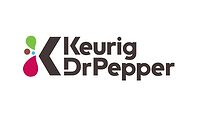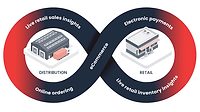On the Route Track
By Elizabeth Fuhrman
Routing software and hardware make containing costs viable
Stop by any time,” family and friends often chime, but most wholesalers would be shocked if customers operated that way. The old cliché applies: Time is money. The distribution business is competitive, but add to that employee expenses, transportation costs and customer satisfaction, and time management becomes essential to efficient operations.
Routing technology is one solution for wholesalers. It
allows distributors to be more competitive in the marketplace by
eliminating the amount of guesswork involved in setting up routes.
“There are a 37 trillion ways to route five
vehicles making 10 stops a day,” explains Cyndi Brandt, marketing
manager at UPS Logistics Technologies, Towson, Md. “It is impossible
for the human mind to determine the best route. Allowing the
software’s algorithm to define the most intelligent plan eliminates
the chance for excess mileage. Less mileage equals less money spent on fuel
and less money spent on driver overtime. Providing customers with current
information regarding deliveries increases customer satisfaction levels and
encourages repeat business.”
Some of the biggest problems beverage distributors
face include reducing the amount of excess mileage driven, driver overtime
and the overall lack of control regarding the order-to-delivery process.
“Incorporating a routing software program can put a significant
amount of money back into the wholesalers’ profit bank,” Brandt
says. “Customer service can provide real-time delivery information to
customers, which allows for a happier customer.”
Creating customer time windows is another feature of
routing software that raises customer satisfaction. Routing software should
take a customer’s delivery time preference into consideration.
TruckStops by MicroAnalytics Inc., Arlington, Va., is one such example.
“By taking the time window into consideration
and by meeting that time window, you are keeping the store owner
happy,” says Dan Buttarazzi, director of marketing for the company.
“Now he knows when to expect you, and it doesn’t throw his
whole day off.”
Keeping an efficient schedule and following a precise
route also reduces the environmental impact that a company makes.
“You are cutting down on the gas use and on the truck
emission,” Buttarazzi says. “A lot of companies are taking that
into consideration now because they want to do everything they can to
minimize environmental damage.”
Distributors can further contain costs by automating
route reconciliation and reducing office labor, says Patrick Pilz, chief
executive officer of CSB-System International Inc., San Diego. Companies
also can accelerate cash flow by faster invoicing and cash collection.
“With a good route planning module in
conjunction with actual data tracking, it is common that companies can
reduce mileage driven by 5 to 10 percent,” Pilz says. “Overtime
and stop times can be reduced significantly as well, but to make this
really work, you need more connectivity to the truck so that you can
capture actuals, such as start and stop times of the engine, open and close
times of doors, etc. These are the data you need to analyze to see where
the driver kills important time and costs.”
Some routing systems can increase efficiency and
effectiveness throughout the warehouse, sales and distribution processes.
Software from Raleigh, N.C.-based Intervolve Inc. provides the ability to
drag and drop orders into other trucks to maximize truck capacity and take
trucks off the street, says Sandy Smith, marketing director for the
company. Intervolve’s Web and mobile software provides anytime access
to information and the ability to save time tracking calls, providing sales
data and recording street-level execution at each account.
Routing solutions also make it easier to gather and
analyze data as well as create actionable objectives. “Wholesalers
can simultaneously zero in on efficiency opportunities and provide valuable
market intelligence at retail,” Smith adds.
Chooser friendly
A wholesaler must define its needs when looking at
purchasing new or upgrading routing hardware and software. “Sit down
and analyze what you are trying to accomplish so you can talk intelligently
with different vendors and compare their products based on your
needs,” says Warren Johnson, senior IT manager and product manager
for dedicated and mobile technology at Ryder Systems Inc., Miami. “If
not, you could be making a bad decision.”
Also, the bigger a distribution business is, the more
difficult it gets to find an optimum solution. From number of vehicles,
products, drivers and clients, and the size of the distribution area, the
larger the scalability the more effective a routing software package would
be, Johnson says.
To optimize routing and scheduling, the best method of
receiving orders would be electronically so they can easily interface with
routing software, he says.
“If you have linkage between the order entry
system and the routing package, then you can do routing dynamically and
that would be preferred because that means in every instance you’d be
able to do the route with the least amount of equipment and miles to
satisfy those demands,” Johnson says. “Out of the routing and
scheduling system, you might then download those routed orders in terms of
loads to a transportation management system, which might provide them to an
onboard computer or a handheld device from an item-level tracking
standpoint. Then as the driver would make the deliveries, if he had the
handheld device, he could scan the product and guarantee that he had been
meeting what had been downloaded. In other words, it would help reduce
overs and shorts for customers.”
Wholesalers should consider multiple issues when
purchasing a handheld system, Brandt says.
“Functionality is a priority,” she
explains. “What do they need the device to do? Measure driver
productivity, prevent service failures, provide driver location
information? Are they most concerned with accessing real-time information
in order to make the route plan better?”
For hardware, distributors also must decide how far
the solution needs to go and how mobile the solution needs to be, Pilz
says.
“Some payback can come from integration into the
truck systems, which would, of course, be more costly,” he explains.
Other things to consider are shelf-life and ruggedness
of the equipment, he says. “Before getting into the process, the
wholesaler needs to clearly understand where the potential savings can come
from, what environment he operates, what customer structure he has, before
he can start shopping for the right solution.”
bMobile Technology, Eagle,
Idaho, offers a new version of Route Manager software that provides
computer systems with mobile invoicing, presales order gathering and full
route management. The system is designed to integrate with the office
accounting system and eliminates the need for redundant data entry and can
streamline the sales process. Barcode scanning, signature capture, load
sheets and inventory control are some of the ways the system helps with
routing.
Intervolve’s solutions support a variety of
handheld devices. “Often, the best device differs by user
scenario,” Smith says. “For example, salespeople can use
full-screen tablets, laptops or Palm or PocketPC devices, depending on
their portability needs and the need to synchronize with the warehouse.
With WiFi capability, these devices can sync from any location. With small,
portable printers, a salesperson could print orders at the customer site or
in the vehicle, whichever is more convenient and efficient. Small
form-factor wireless printers can save a significant amount of time by
providing immediate print-outs without having to go back outside to the
vehicle.”
Another aspect to consider is whether the routing
software program integrates with GPS tracking
software. A GPS device can be placed in a bed of a truck to pinpoint where
the truck is at all times. In addition, routing software programs can be
uploaded into the GPS unit. If the driver has a computer onboard, this
allows the driver to punch in where he is supposed to be for the day, what
he is delivering and how much he is delivering. On the other side, the
headquarters location can know if the driver is in his cab, where the
driver is along his route, the reason a driver could be running late, road
conditions he is experiencing, and speeds driven along the way.
“The systems are so advanced they can even tell
the braking conditions,” Buttarazzi says. “Is he hitting the
brakes too hard? Or how long was he in first
gear, when he should have been shifting to second?”
Ease of use
Distribution companies can motivate drivers, delivery
personnel and salespeople on the benefits of routing software and hardware
by allowing them to be involved in the entire process.
“Provide the staff with information on how this
solution will allow greater success for the organization, and in turn,
benefit employees,” Brandt says. “Explain how the different
tools will be useful in relation to each employee’s position.”


